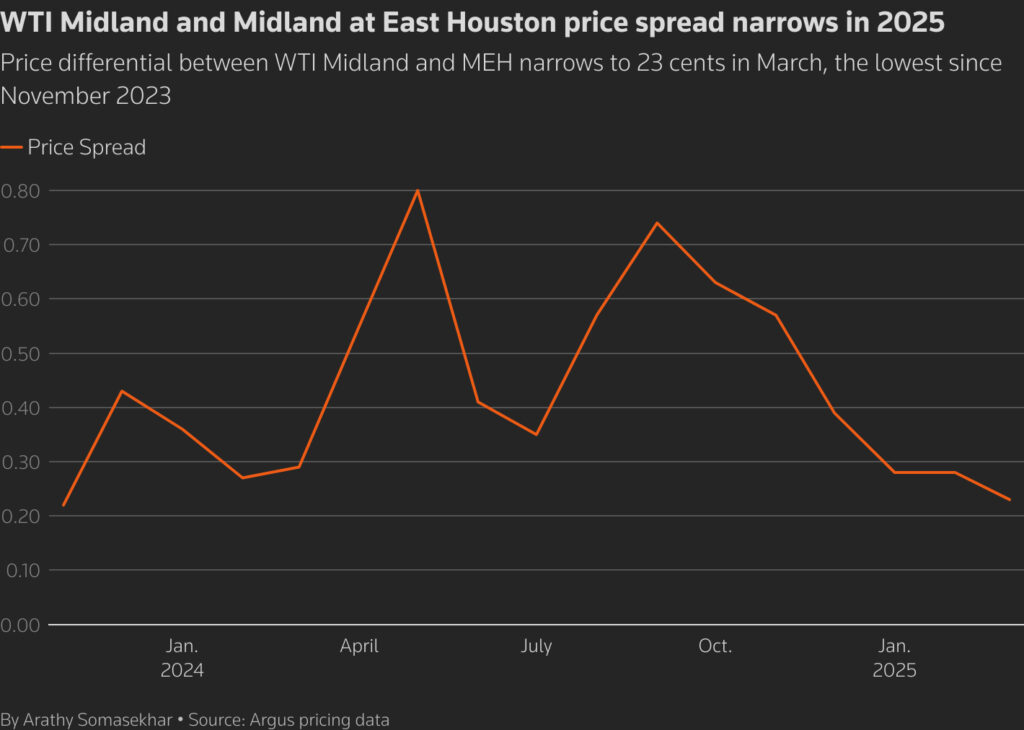- Cold weather impacts about 1.8 mln barrels of Permian output – analyst
- Midwest refiners seek Midland crude to cut dependency on Canadian light – analyst
- U.S., Europe refinery maintenances cut demand at the coast
- Narrow price differential between WTI Midland and MEH expected to be temporary – analysts to be temporary – analysts

HOUSTON, March 6 (Reuters) – The price spread between WTI Midland crude in West Texas and Houston has narrowed this year as cold weather hurt Permian production, driving up prices, but weaker refinery and export demand on the U.S. Gulf Coast pressured that market lower.
The spread between the two pricing points narrowed to 23 cents in March, the lowest since November 2023. That compared to an average of 50 cents a barrel a year ago, when record crude production at the top U.S. Permian oilfield and strong export demand for WTI Midland crude widened price differentials.
WTI Midland crude traded at a $1.08 premium to U.S. crude futures in March, easing from a 11-month high of $1.22 in the previous month, data from pricing agency Argus showed.
The jump in prices in February came as 1.8 million barrels in the Permian were cut by the recent cold weather that hit operations, according to estimates from analysts at consultancy Energy Aspects.
Meanwhile, Permian-quality crude at the Magellan East Houston (MEH) terminal, the main price assessment point along the Gulf Coast, traded at a $1.31 premium to U.S. crude futures. That compared to a $1.47 premium last year.
A 10% tariff by the U.S. government on Canadian crude also pressured the spread as Midwest refiners were seeking WTI-Midland crude to Cushing to replace Canadian light sweet oil, said Energy Aspects analyst Jeremy Irwin.
Permian to Cushing pipeline flows are tracking 100,000 barrels per day higher year-over-year for the first quarter, Irwin said. Cushing inventories have been near operational lows in recent months, but climbed to about 25.7 million barrels last week, its highest level in four months.
Energy Aspects said it has increased its expectations for flows on the BP 1 pipeline, which runs from Cushing to BP Plc’s (BP.L) Whiting refinery in Illinois and the Ozark pipeline, which connects Cushing to refineries in Wood River, Illinois, as inland refiners to pull more WTI Midland barrels given tariffs.

Bar chart showing that price spread between WTI Midland and Midland at East Houston narrowed in 2025
WEAK DEMAND ALONG THE COAST
Four-week average U.S. refinery utilization stood at 85.6% in the week to February 26, data from the U.S. Energy Information Administration showed, as fuel producers undergo maintenance ahead of summer driving season.
Net input of crude oil to refiners on average over 4 weeks to the last week was 15.5 million, 4.2% lower than average 2024 levels. Also capping demand was the final shutdown of LyondellBasell Industries’ (LYB.N) 263,776 barrel-per-day (bpd) Houston refinery this month.
U.S. crude export volumes also eased 9,000 bpd to 3.88 million bpd in February, as spring refinery maintenance in Europe cut flows, and as China implemented a 10% retaliatory tariff on U.S. oil. China accounted for about 5% of U.S. crude exports in 2024.
America’s excess light-sweet supply is struggling to attract international interest, pressuring MEH to soften to attract international buyers, said Irwin.
The narrow price differential between WTI Midland and MEH is expected to be temporary, however, Wood Mackenzie analyst Dylan White said, as refinery maintenance season resolves through spring, and on the back of strong Permian production growth and increased use of available pipeline capacity.
Reporting by Arathy Somasekhar in Houston; Editing by Liz Hampton and David Evans
Share This:




 CDN NEWS |
CDN NEWS |  US NEWS
US NEWS 































